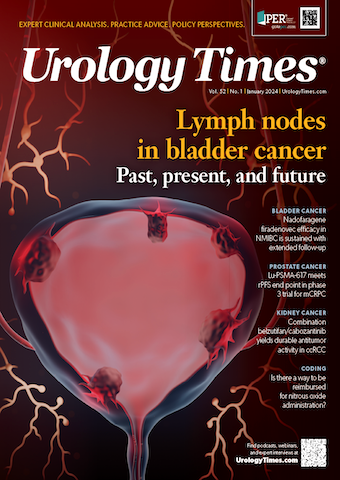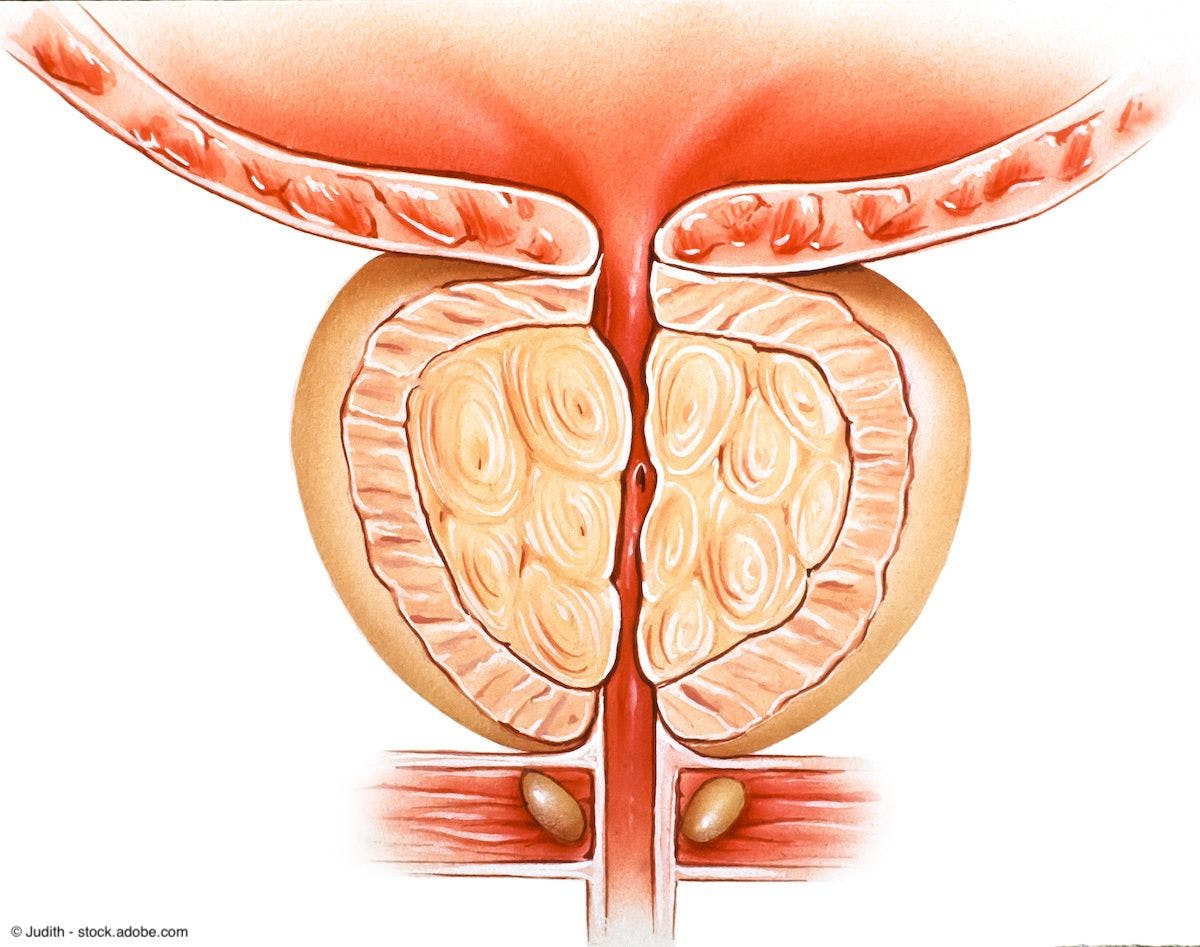Feature
Article
Urology Times Journal
Lymph nodes in bladder cancer: Past, present, and future
Author(s):
"Based on the LEA and S1011 trials, it has become clear that patients do not benefit from an extended LND, and a standard bilateral pelvic LND is the standard of care," write Amir Soltani-Tehrani, MD, and Kamal S. Pohar, MD.
Soltani-Tehrani is a clinical research fellow in the Department of Urology at The Ohio State University in Columbus.
Pohar is an associate professor in urology and the Julius and Diana Skestos Chair in Urology at The Ohio State University in Columbus.
Amir Soltani-Tehrani, MD

At the time of radical cystectomy (RC) for muscle-invasive bladder cancer (MIBC), a pelvic lymph node dissection (LND) is recommended, even in patients who are clinically node negative, as up to 25% of patients have pathologic node-positive disease.1 Therefore, it is widely accepted that a pelvic LND provides a staging benefit, allowing for better prognostication and determining the need for adjuvant therapy. Several retrospective studies reported the bilateral potential of pelvic lymph node metastases from bladder cancer, including the involvement of nodes outside of the true pelvis. This was further confirmed in a multicenter prospective lymph node mapping study in 290 patients that included removing lymph nodes in the true pelvis, as well as lymph nodes up to the level of the inferior mesenteric artery (IMA).2 The LND was divided into 12 anatomic regions and the probability of pathologic lymph node metastases at the time of RC for MIBC was determined. The study corroborated prior findings that the majority of lymph node metastases from bladder cancer occurs in the true pelvis. However, as many as 8% to 10% of patients also had metastasis outside the true pelvis, including the common iliac and para-aortic lymph nodes. Additional studies suggested up to 25% of patients with pathologic N1 to N3 disease can be cured long term without adjuvant therapy following RC, implying a therapeutic benefit to LND.1,3,4
Kamal S. Pohar, MD

Therefore, it may seem intuitive that a more extensive LND to the level of the aortic bifurcation or IMA (extended LND) may cure more patients of bladder cancer when compared with an LND below the bifurcation of the common iliac artery (standard LND). Until very recently, the evidence of whether to perform an extended LND for therapeutic benefit was based on retrospective studies and inherent limitations of this type of study design. A 2014 meta-analysis summarized the prior retrospective studies and found that 5-year recurrence-free survival (RFS) was 62% vs 55% (P < .001) when comparing extended vs standard LND.5 Similar oncologic benefits from retrospective data supported a more extensive LND in pancreatic, esophageal, and gastric cancer. However, later randomized clinical trial evidence in each of these cancers determined there was no survival benefit to a more extensive LND when compared with a lesser LND.6-9
To more conclusively determine whether there is a therapeutic benefit of an extended LND compared with a standard LND at the time of RC for bladder cancer, 2 randomized clinical trials were initiated in Germany and the United States, and the findings were recently reported. A phase 3 multicenter clinical trial was conducted in Germany under the name of LEA AUO AB 25/02, with a primary end point of RFS.10 Eligibility criteria included not only patients with cT2 to T4a but also T1G3 bladder cancer and excluded patients who received neoadjuvant chemotherapy (NAC). Sample size calculations determined a need to randomly assign 400 patients based on a 5-year RFS of 65% for extended LND and 50% for standard LND, thereby expecting a 15% RFS improvement (P < .05; 2-sided, 80% power) for extended LND. The study found that an extended LND led to a slight improvement in 5-year RFS. However, this failed to meet statistical significance (65% vs 59%; HR, 0.86; 95% CI, 0.58-1.22; P = .36). Secondary end points of cancer-specific survival (76% vs 65%; HR, 0.70; 95% CI, 0.46-1.07; P = .10) and overall survival (OS; 59% vs 50%; HR, 0.78; 95% CI, 0.57-1.07; P = .12) also did not meet statistical significance. Thus, the study concluded there was no benefit to extended LND. Study limitations included omitting surgical removal of lymph nodes posterior to the obturator nerve in the group receiving a standard LND, inclusion of patients with T1G3 disease (ie, 14% of the total study population) who have a lower likelihood of lymph node metastasis, and excluding patients who received NAC as this is a contemporary standard of care.11
A second phase 3 multicenter clinical trial conducted in the US, the S1011 study led by the Southwest Oncology Group, also compared RFS between extended and standard LND at the time of RC. Trial results were presented at the 2023 American Society of Clinical Oncology Annual Meeting.12 In this trial, the sample size was based on a lower expected 10% improvement in 3-year RFS for extended LND (65%) compared with standard LND (55%). To achieve a 1-sided a = 0.025 and 85% power, 564 eligible patients were required. From August 2011 to February 2017, a total of 292 patients were randomly assigned to extended LND and 300 patients to a standard LND, including removal of lymph nodes posterior to the obturator nerve. Patients were randomly assigned to the 2 arms based on clinical stage (cT2 or ≥ cT3), receipt of NAC, and performance status. Unique features of the trial included credentialing surgeons based on recent surgical volume and quality in performing RC, intraoperative randomization scheme after excluding the presence of clinical lymph node metastasis to the common iliac nodes, and surgeon submission of intraoperative photos and/or videos of the quality of LND for every patient enrolled in the trial. The study concluded there was no difference in RFS or OS between extended LND compared with standard LND (HR, 1.10; 95% CI, 0.87-1.42; P = .82 for DFS and HR, 1.15; 95% CI, 0.89-1.48; P = .87 for OS). An additional important finding was a higher rate of grade 3 to 5 adverse events and 90-day mortality in the extended LND (5.5% vs 3.0%).
Based on the LEA and S1011 trials, it has become clear that patients do not benefit from an extended LND, and a standard bilateral pelvic LND is the standard of care. Whether there are selected patients who may benefit from a more extensive LND needs to be determined. The trials accrued very few patients with cN1 to N2 lymph node metastasis, excluded patients with cN3 disease, and a subanalysis of the S1011 trial suggested a possible RFS benefit for extended LND in patients with more advanced bladder cancer (ie, pT3/T4a). Therefore, there may be a few undetermined exceptions, but the data are clear that most patients undergoing RC for bladder cancer do not benefit from an LND above the bifurcation of the common iliac artery. A standard LND is the standard of care, but it must be performed diligently, leading to thorough skeletonization of the described anatomic boundaries to maximize benefit.
REFERENCES
1. Zehnder P, Studer UE, Daneshmand S, et al. Outcomes of radical cystectomy with extended lymphadenectomy alone in patients with lymph node‐positive bladder cancer who are unfit for or who decline adjuvant chemotherapy. BJU Int. 2014;113(4):554-560. doi:10.1111/bju.12520
2. Leissner J, Ghoneim MA, Abol-Enein H, et al. Extended radical lymphadenectomy in patients with urothelial bladder cancer: results of a prospective multicenter study. J Urol. 2004;171(1):139-144. doi:10.1097/01.ju.0000102302.26806.fb
3. Skinner DG. Management of invasive bladder cancer: a meticulous pelvic node dissection can make a difference. J Urol. 1982;128(1):34-36. doi:10.1016/s0022-5347(17)52740-8
4. Tarin TV, Power NE, Ehdaie B, et al. Lymph node–positive bladder cancer treated with radical cystectomy and lymphadenectomy: effect of the level of node positivity. Eur Urol. 2012;61(5):1025-1030. doi:10.1016/j.eururo.2012.01.049
5. Mandel P, Tilki D, Eslick GD. Extent of lymph node dissection and recurrence-free survival after radical cystectomy: a meta-analysis. Urol Oncol.2014;32(8):1184-1190. doi:10.1016/j.urolonc.2014.01.017
6. Farnell MB, Pearson RK, Sarr MG, et al. A prospective randomized trial comparing standard pancreatoduodenectomy with pancreatoduodenectomy with extended lymphadenectomy in resectable pancreatic head adenocarcinoma. Surgery. 2005;138(4):618-630. doi:10.1016/j.surg.2005.06.044
7. Omloo JM, Lagarde SM, Hulscher JB, et al. Extended transthoracic resection compared with limited transhiatal resection for adenocarcinoma of the mid/distal esophagus: five-year survival of a randomized clinical trial. Ann Surg. 2007;246(6):992-1001. doi:10.1097/SLA.0b013e31815c4037
8. Lagergren J, Mattsson F, Zylstra J, et al. Extent of lymphadenectomy and prognosis after esophageal cancer surgery. JAMA Surg. 2016;151(1):32-39. doi:10.1001/jamasurg.2015.2611
9. Sasako M, Sano T, Yamamoto S, et al. D2 lymphadenectomy alone or with para-aortic nodal dissection for gastric cancer. N Engl J Med. 2008;359(5):453-462. doi:10.1056/NEJMoa0707035
10. Gschwend JE, Heck MM, Lehmann J, et al. Extended versus limited lymph node dissection in bladder cancer patients undergoing radical cystectomy: survival results from a prospective, randomized trial. Eur Urol. 2019;75(4):604-611. doi:10.1016/j.eururo.2018.09.047
11. Clinton TN, Huang C, Goh AC. Is there an oncological benefit to extended lymphadenectomy for muscle-invasive bladder cancer? Transl Androl Urol. 2020;9(6):2956-2964. doi:10.21037/tau-20-406
12. Lerner SP, Tangen C, Svatek RS, et al. SWOG S1011: a phase III surgical trial to evaluate the benefit of a standard versus an extended lymphadenectomy performed at time of radical cystectomy for muscle invasive urothelial cancer. J Clin Oncol.2023;41(suppl 16):4508. doi:10.1200/JCO.2023.41.16_suppl.4508






























